One of the biggest draws to Baja for us was the chance to see migrating grey whales. Every year around 12,000 grey whales migrate from the Arctic to give birth to their calves in three protected lagoon areas on Baja’s Pacific coast. These lagoons are the only places in the world where grey whales give birth; two lagoons, Ojo de Liebro and Laguna de San Ignacio are at the more northerly end of Baja Sur and since the whales arrive here first, our chances of seeing them were better than further south. They begin arriving in December and the majority of the calves are born between February and April.
We are currently in Guerrero Negro, but our search for whales began at San Ignacio, a date palm oasis about two hours south of here. That town is a sweet slice of old Baja, with a sleepy centre plaza and colourful old buildings.

The day we arrived the town was buzzing with activity. There was a pile of jeeps and drivers connected to the Baja XL endurance rally out of the U.S. This seemed to us to be both gruelling and exciting – 4000 km. in 10 days. We spoke to the couple who owned this vehicle; they were along for the ride as spectators and friends and didn’t have the stress of competing.

The very next day, you might have seen tumbleweed blowing through town – scarcely a soul around. It may be languid, but the shopowners haven’t gone to sleep. We paid over $5 each for an ice-cream cone; probably making up for a slow start to the tourist season.
Right in front of the plaza is the San Ignacio Mision, which was originally built by the Jesuits, but rebuilt again in 1786 after they were expelled from Mexico.
The missions throughout Baja are so beautiful, but they all come with the same heavy price; indigenous populations wiped out by European disease introduced by the missionaries.
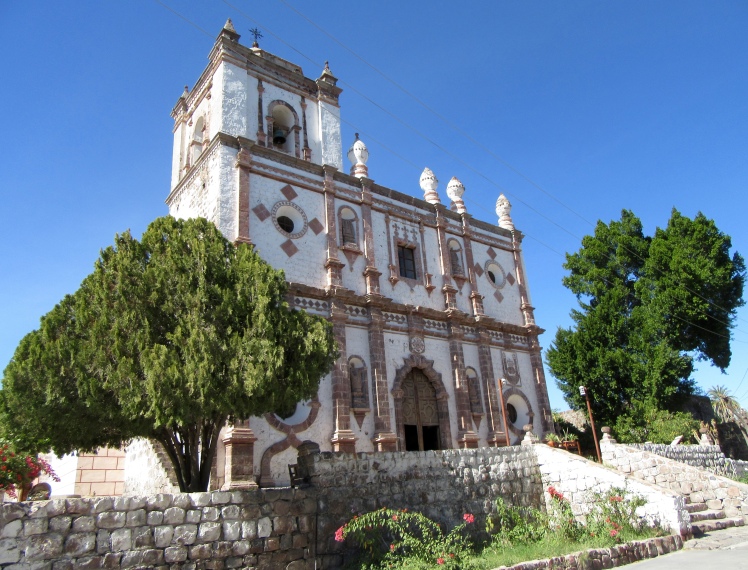
So many small pueblos in Baja are dusty and somewhat unappealing, but the oasis towns are exactly the opposite; lush and colourful with water sources and groves of citrus and date palms. The entrance to San Ignacio is enchanting. First there is the drive past the lagoon which is part of Rio San Ignacio.

Just past the lagoon, the road is lined with date palms.
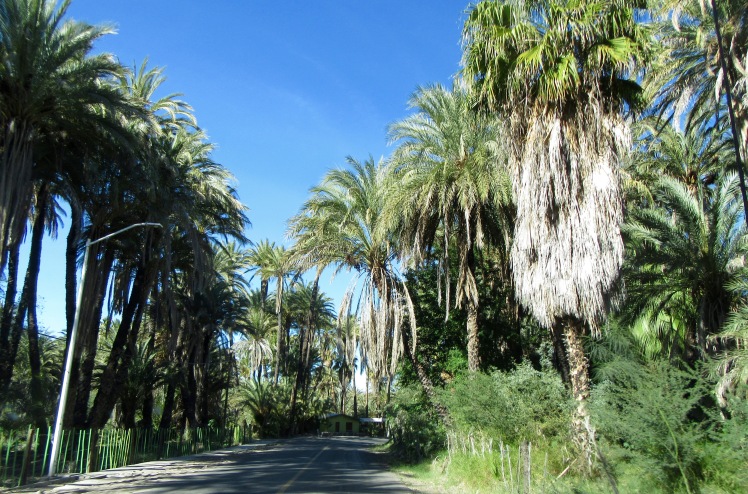
There are a number of appealing RV parks by the oasis, just before town, but unfortunately we were not able to stay there, as the larger spots were already taken and our trailer would not navigate some of the tight turns. We ended up staying at an RV park, Rice and Beans, just off the highway, which was fine for a couple of nights but not nearly as atmospheric.
Our main event was a trip out to Laguna de San Ignacio in search of whales, and we headed out with great anticipation. We had been advised to arrive at the lagoon before 9:00 or 9:30 and hop on any of the waiting boats for a tour. The road out was over 50 km. from town to lagoon and at first, it was a marvel of fresh pavement and beautiful scenery. We had the road to ourselves and we were on our way to see baby grey whales!
Then, the road turned to dirt (still okay) and then to washboard (horrible). We bumped and jolted along for about 15 km., listening to our truck make unusual noises and bangs and cursing mightily all the way.

We stopped to take photos of the salt flats and brackish water; a rather eerie moonscape, made more eerie by the fact there was not another soul on the road.

A little further along we began to see osprey nests, first one, then a couple, then a whole slew of them. Ospreys are very prevalent in this area and in Guerrero Negro.

A few signs of life began to materialize. Life is not luxurious out here – this building is typical of the few homes scattered by the lagoon.
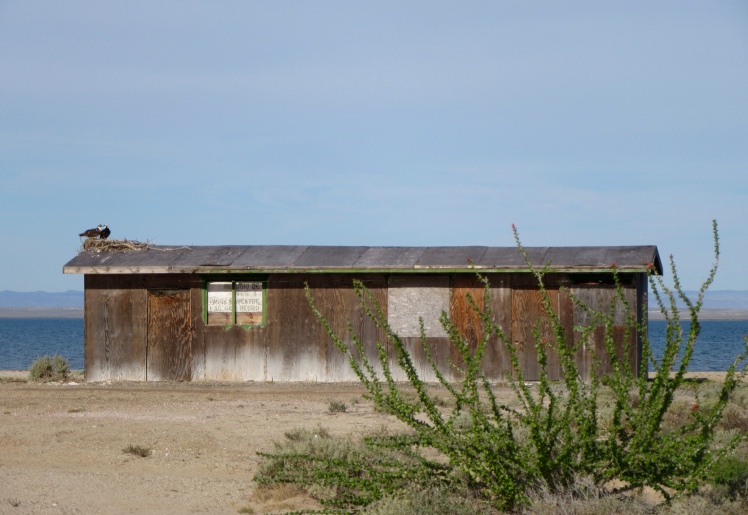
After more than an hour of driving, we arrived in the little town to discover that there were no lineups of boats clamouring for our business. No-one was willing to take us out to see the whales. We had arrived a couple of weeks too early to guarantee sightings and understandably, it was not worth their time and gas to take out just two people.
So we began the long drive back and stopped to take this photo. One lone vehicle on a really bad road in the middle of nowhere. A certain desolate beauty.

Okay, now we were pinning all our hopes on Guerrero Negro, about two hours north, as our last chance to see grey whales before we left Baja.
We pulled into the Malarrimo Hotel with space at the back for RVs. Not exactly parkland, but clean and well-kept and secure. The people here are lovely and they offer whale-watching tours, so we signed up for an 8:00 am departure this morning.
We woke up to fog and cold, which is pretty much the climate here at Guerrero Negro, but dressed in layers and within an hour the fog had lifted. In fact, it made for better conditions, as the water was calm and the light was soft.
We drove to the lagoon with a party of seven; two Germans, two French, one Californian and us. After about 10 minutes on the water, the captain pulled up beside a large structure, filled with sea lions sunning themselves. They are pretty darn cute – I’ve never seen them so close up.
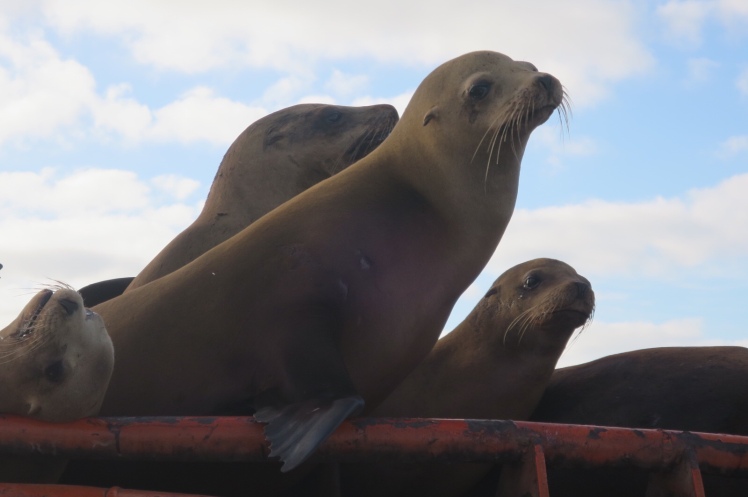
The trip started slowly, as whale-watching trips tend to do. The first sighting brought us all to our feet, with cameras aimed:
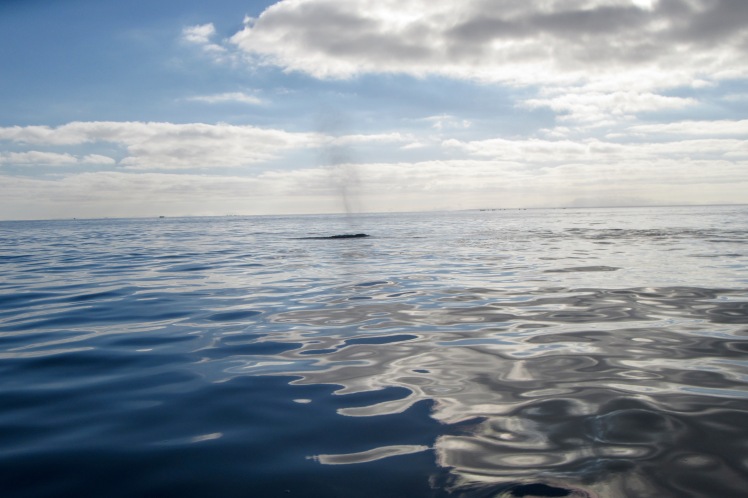
The captain steered quietly and slowly toward the whale and then cut the motor. The operators here are extremely respectful of the whales. Boats are small and keep a discreet distance from the whales. They are never chased but the operators allow them to approach the boat, if they choose. We were out for two hours and only saw two other boats, in part because the season has only just started.
More whales began to appear; at times we were surrounded on all sides by dozens of whales. Our captain thought there were about 100 whales in the lagoon right now – there are up to 1000 in peak season. Guerrero Negro has the largest collection of cetaceans in the world during the grey whale birthing and migratory period.
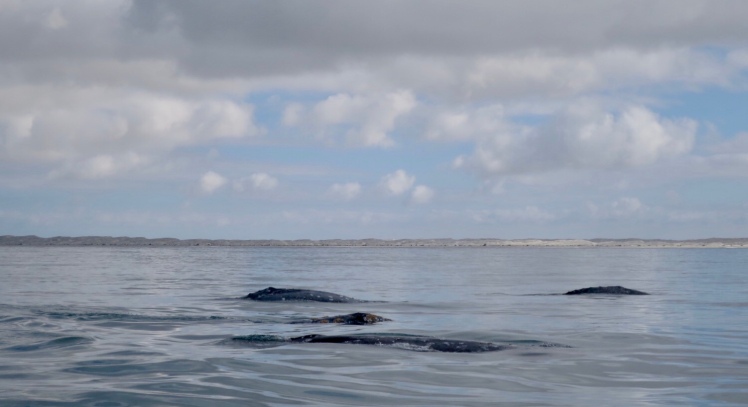
There are challenges with trying to photograph whales on a rocky boat without a tripod. There is that split second between the money shot and this:

Who knows what I missed while I was taking dozens of fascinating shots of the sky:

We did not get any dramatic breaches, but a number of straight up head shots.
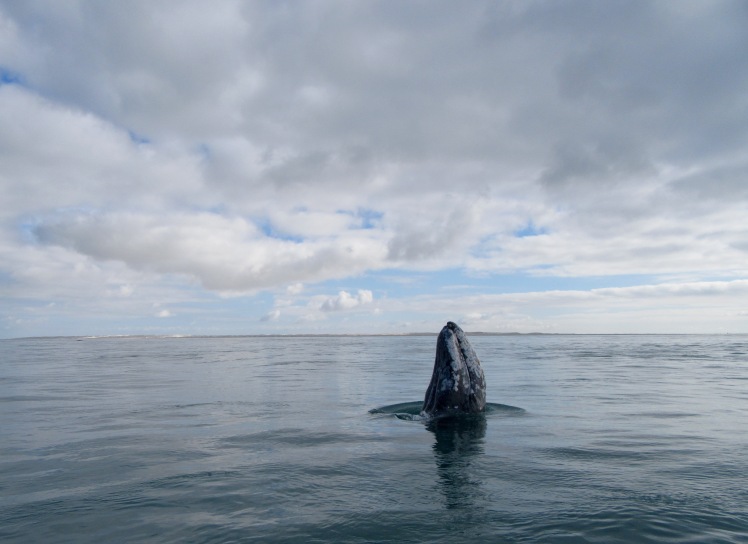
And a number of whale tails:
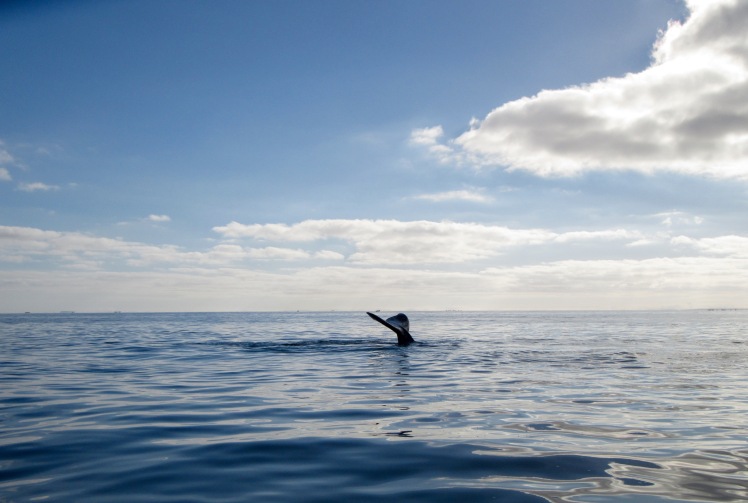
And then our whales began to get closer and closer. Our captain was so excited – this was the first day he was out this season where there were so many whales – lucky us.
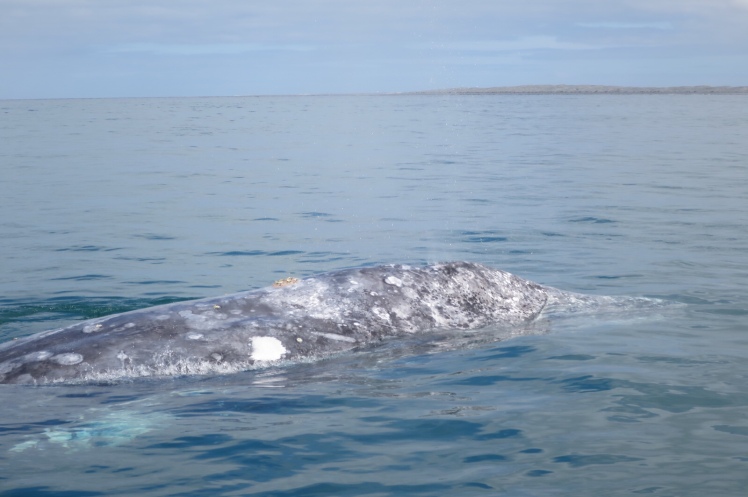
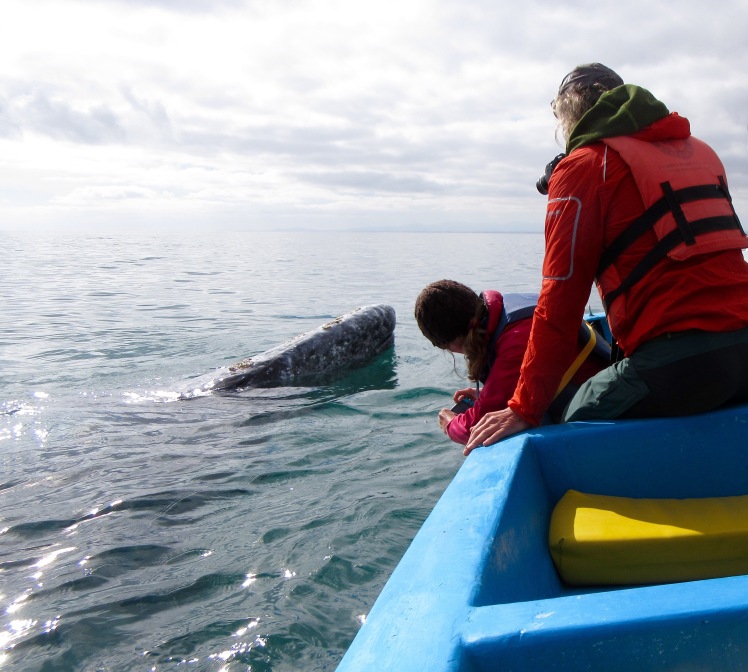
Incredibly, a big grey went right under our boat and emerging on the other side.

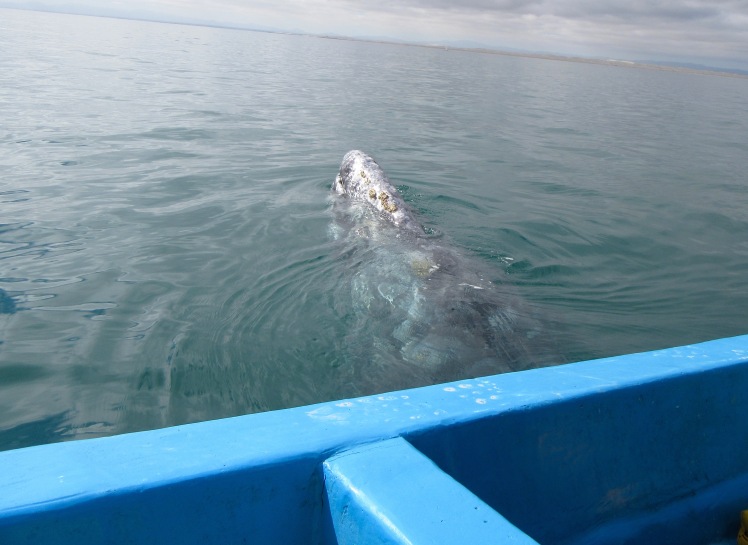
She was so close to the side of the boat, I almost touched her fin. A little later in the season, once the mamas are more comfortable, they will bring their babies right up to the boat to be touched and petted. We are so sorry to have missed out on that incredible privilege to have such an intimate encounter with these whales, but feel fortunate to have spent this much time with them.
On our way back to shore, we were treated to one last little marine treat. A dolphin played around our boat for a while and then our captain said, “Adios, ballenas” and it was time to go.
I will never forget this incredible experience – a highlight of our time in Baja.
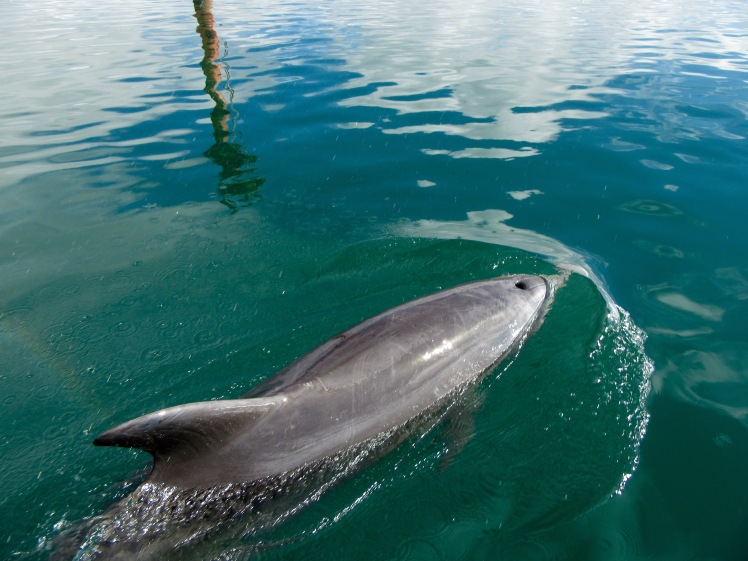
Tomorrow the highway veers back over to Sea of Cortez and Bahia de los Angeles, or Bay of LA, as it is known among the tourists. More beach camping and with any luck, more swimming for a few days before we make our way to the border.
Hope you don’t have to climb a wall to get back across. Lol. Quite an experience you had this week. It’s going to be difficult to equal these last few weeks.
LikeLike
Yes, as much as we’re looking forward to seeing new sights, we may be leaving our laid-back mood behind once we cross La Frontera. 😉
LikeLike
Thrilled to experience the grey whales through your eyes…especially the playful dive under your boat!
Sounds like you have “done” Baja beautifully. Savour your final days in Mexico. Safe journey to Trumpland and more adventures.
LikeLike
Thanks Kris – right now we are hanging out on a fishing beach in Baja, reading and relaxing. Dosing up on time by the sea before we dive back into the desert landscape again, but looking forward to whatever comes our way.
LikeLike
Really enjoyed your blog! visually captivating!…Inspiring for us to look forward to! Muchas gracias amigos!
LikeLike
So happy to hear you were able to see the whales before heading back up north. We have been fortunate to see some off the coast of Vancouver Island and it was thrilling, to say the least!
LikeLike
Heather, I never get tired of seeing whales – it is always exciting. I guess in part because they are hidden from view most of the time and that adds to their mystery. this was the first time we had the opportunity to be up so close to them – I hope to repeat that experience again one day.
LikeLike